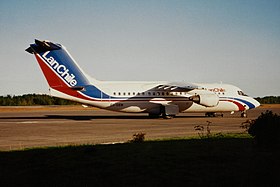LAN Chile Flight 1069
| LAN Chile Flight 1069 | |
|---|---|
|
An identical BAe 146-200 from LAN Chile |
|
| Accident summary | |
| Accident type | Agreement from the runway , fall into the sea |
| place |
Beagle Channel , near Puerto Williams , Chile |
| date | February 20, 1991 |
| Fatalities | 20th |
| Survivors | 52 |
| Injured | 17th |
| Aircraft | |
| Aircraft type |
|
| operator |
|
| Mark |
|
| Departure airport |
Punta Arenas Airport , Chile |
| Destination airport |
Puerto Williams Airport , Chile |
| Passengers | 66 |
| crew | 6th |
| Lists of aviation accidents | |
The LAN Chile flight 1069 (flight number IATA: LA1069 , ICAO: LAN1069 ) was a domestic charter flight of LAN Chile from Punta Arenas to Puerto Williams in Tierra del Fuego . On February 20, 1991, a serious incident occurred on this flight when the BAe 146-200A deployed in Puerto Williams rolled over the end of the runway and fell into the Beagle Channel . In the accident, 20 people were killed and 52 survived.
plane
The aircraft involved in the accident was a British-made BAe 146-200A . The machine was the work of British Aerospace at the factory airfield Woodford , Metropolitan Borough of Stockport , final assembly. The aircraft had the factory number E2061. The machine had completed its maiden flight on August 26, 1986 with the test registration G-OHAP . Then in September 1986 it was briefly approved by the manufacturer as G-5-061 . In the same month the delivery to the Presidential Airlines followed . The machine received the aircraft registration N493XV . In March 1990 the machine went to LAN Chile, where it went into operation with the identification CC-CET . The four-engine short - haul aircraft was equipped with four Lycoming ALF502R-5 engines.
The BAe 146 is a jet-propelled aircraft specially designed for operation at airports with short runways. With its four engines, it is designed for flat landings where the nose and main landing gear hit the runway at the same time. The machine has powerful wheel and air brakes with large spoilers to stop the lift immediately after touchdown. The machines do not have a thrust reverser .
The aircraft was one of three BAe 146 aircraft in service with LAN Chile at the time (the other two aircraft were CC-CEJ and CC-CEN ).
Passengers and crew
The flight was a charter flight from LAN Chile. The passengers on board were mostly European and American tourists. These should travel from Puerto Williams by ship to Antarctica . The ship with which the voyage was to begin, the Society Explorer , was docked at the main pier in Puerto Williams at this time. On board the BAe 146 there were 66 passengers, the six-person crew consisted of a flight captain, a first officer and four flight attendants.
the accident
The flight took off at 2:51 p.m. from the airport in Punta Arenas and proceeded without incident until the approach to Puerto Williams. At 3:15 p.m., the pilots were given clearance to make an approach to runway 26 aligned with the radio beacon . At that time there was a tail wind (wind direction 180 degrees) with wind speeds of around four knots. Shortly afterwards, the air traffic controller reported a wind speed of 6 knots from an angle of 160 degrees. The master then decided to make a direct approach on runway 08, which was confirmed by air traffic control.
According to the flight schedule, the aircraft touched down on the runway in Puerto Williams at 3:24 p.m. The point of touchdown was 427 meters behind the runway threshold of the 1,440 meter long runway. The touchdown speed was 112 knots (approx. 207 km / h), the targeted landing speed would have been 103 knots (approx. 189 km / h). The machine rolled down the sloping runway 08, rolled over the end of it and fell into the Beagle Channel . When exiting the runway and taxiing over the beach, engine no. 2 broke off.
Salvage and rescue
First the bow of the engine sank into the water. Passengers who managed to escape from the plane climbed onto the wings and top of the fuselage to be rescued from there.
Employees of the Chilean Navy, Society Explorer , the airport and residents of the city of Puerto Williams came to the rescue. The passengers were rescued with Zodiac boats of the Chilean Navy and the Society Explorer , which were the first to arrive at the machine. Finally, a naval patrol boat was added. With the help of the boats 53 people were rescued alive. The 20 people killed in the accident were all US tourists.
The cause of the accident was found to be the late touchdown on a sloping runway with aquaplaning and ice formation on the runway surface. However, the aircraft was generally suitable for this type of flight, both for shorter runways and for routes with ice. In fact, this type of aircraft is still used today for travel to Antarctica.
swell
- Accident report BAe 146-200, CC-CET Aviation Safety (English), accessed on February 25, 2019.
- 19 US TOURISTS KILLED IN BEAGLE CHANNEL CRASH , Washington Post
- Operating history of the machine on Planespotters
Individual evidence
- ↑ LAN Chile Fleet Details Airfleets.net , accessed on April 22, 2019.
